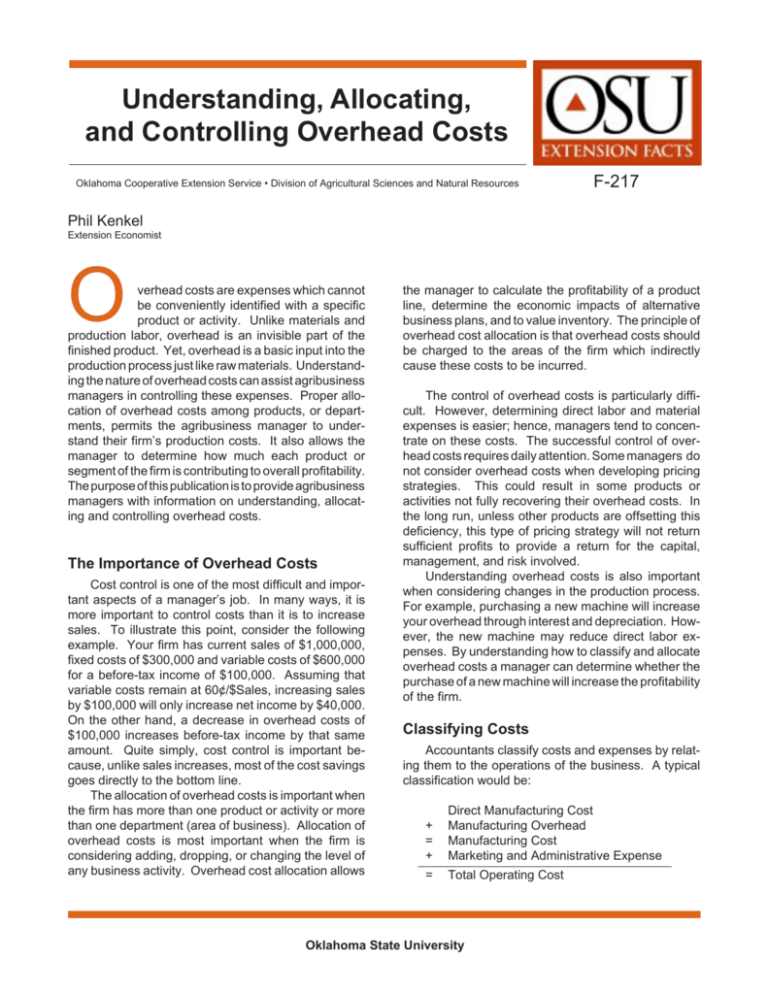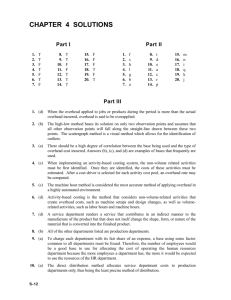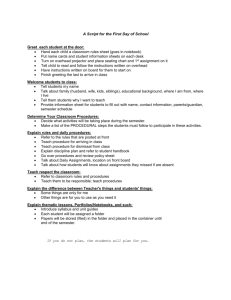F-217, Understanding, Allocating, and Controlling Overhead Costs
advertisement

Understanding, Allocating, and Controlling Overhead Costs Oklahoma Cooperative Extension Service • Division of Agricultural Sciences and Natural Resources F-217 Phil Kenkel Extension Economist O verhead costs are expenses which cannot be conveniently identified with a specific product or activity. Unlike materials and production labor, overhead is an invisible part of the finished product. Yet, overhead is a basic input into the production process just like raw materials. Understanding the nature of overhead costs can assist agribusiness managers in controlling these expenses. Proper allocation of overhead costs among products, or departments, permits the agribusiness manager to understand their firm’s production costs. It also allows the manager to determine how much each product or segment of the firm is contributing to overall profitability. The purpose of this publication is to provide agribusiness managers with information on understanding, allocating and controlling overhead costs. the manager to calculate the profitability of a product line, determine the economic impacts of alternative business plans, and to value inventory. The principle of overhead cost allocation is that overhead costs should be charged to the areas of the firm which indirectly cause these costs to be incurred. The control of overhead costs is particularly difficult. However, determining direct labor and material expenses is easier; hence, managers tend to concentrate on these costs. The successful control of overhead costs requires daily attention. Some managers do not consider overhead costs when developing pricing strategies. This could result in some products or activities not fully recovering their overhead costs. In the long run, unless other products are offsetting this deficiency, this type of pricing strategy will not return sufficient profits to provide a return for the capital, management, and risk involved. Understanding overhead costs is also important when considering changes in the production process. For example, purchasing a new machine will increase your overhead through interest and depreciation. However, the new machine may reduce direct labor expenses. By understanding how to classify and allocate overhead costs a manager can determine whether the purchase of a new machine will increase the profitability of the firm. The Importance of Overhead Costs Cost control is one of the most difficult and important aspects of a manager’s job. In many ways, it is more important to control costs than it is to increase sales. To illustrate this point, consider the following example. Your firm has current sales of $1,000,000, fixed costs of $300,000 and variable costs of $600,000 for a before-tax income of $100,000. Assuming that variable costs remain at 60¢/$Sales, increasing sales by $100,000 will only increase net income by $40,000. On the other hand, a decrease in overhead costs of $100,000 increases before-tax income by that same amount. Quite simply, cost control is important because, unlike sales increases, most of the cost savings goes directly to the bottom line. The allocation of overhead costs is important when the firm has more than one product or activity or more than one department (area of business). Allocation of overhead costs is most important when the firm is considering adding, dropping, or changing the level of any business activity. Overhead cost allocation allows Classifying Costs Accountants classify costs and expenses by relating them to the operations of the business. A typical classification would be: 217 / 1 + = + Direct Manufacturing Cost Manufacturing Overhead Manufacturing Cost Marketing and Administrative Expense = Total Operating Cost Oklahoma State University In agribusiness, manufacturing overhead and marketing and administrative expenses are often combined into a general overhead category. For example, the manager’s and bookkeeper’s salary, interest and depreciation on the office building, and the fees for the market news service may all be classified as “General Overhead.” Economists classify costs according to their relationship with changes in the volume of production. Variable costs are costs which increase or decrease in direct proportion to the volume of production. Fixed costs are costs which are fixed in total amount within a relevant output range. Some costs, called semivariable costs, contain fixed and variable elements. For example, electricity costs may be semivariable. Electricity used for lighting the plant will not vary with the volume of production. On the other hand, electricity used to operate equipment will increase as the plant’s output increases. Overhead costs are costs which cannot be directly identified with a product or production activity. Overhead costs can be either fixed or variable. Examples of fixed factory overhead costs include depreciation, interest, rent, insurance, taxes, advertising, maintenance, and the manager’s salary. Variable overhead costs might include some categories of supplies, utilities, communication costs, receiving costs and miscellaneous labor costs. For the small agribusiness operation, most overhead costs tend to be fixed. The classification of costs will be shown to be important when pricing strategies and break-even analysis are discussed. rienced a 30 percent increase in productivity after implementing a total quality management system with no increased investment. Every manager is familiar with the adage “advertising doesn’t cost, it pays.” In order to survive, a firm must be customer oriented. However, it must also control the costs created by sales and promotional activities and use these funds effectively. Managers can reduce sales costs by relating sales incentives to the profitability (as opposed to the sales price) of the product. Developing a well-thought-out, long-run plan for advertising and promotion can also reduce sales expenses. Too often, sales efforts are erratic and fail to achieve meaningful results. A careful analysis of sales expenditures may allow reduction and reallocation of sales expenditures while increasing advertising effectiveness. Maintenance and repairs are carried out in order to keep equipment running. The overall objective is to keep equipment running in order to meet production goals. Corrective maintenance involves making minor changes in design, materials or construction. Predictive maintenance involves using sensing, measuring or control devices to identify and correct problems before a break-down occurs. Repairs describe maintenance work done to return equipment to production. Preventive maintenance involves work undertaken on a predetermined schedule when corrective maintenance is not justified, predictive maintenance cannot be applied and repair maintenance is too costly. Each type of maintenance carries its own cost, but few managers fully consider their options in reducing maintenance costs. Recording repairs for each machine is vital in controlling maintenance costs. Equipment history is important in considering the best type of replacements to buy. Furthermore, a few machines often contribute more than their share to costs. Industry surveys have shown that 3 percent of the equipment are responsible for 25 percent of the total maintenance costs. To get a quick look at the potential benefits from control of transportation expense, compare 10 percent of your transportation costs with your net profits for last year. If it represents 20 percent of your profit, your firm is not unusual. Should your firm be in the transportation business? Have you compared the total cost of transportation with the costs of having an outside firm perform these services? Other techniques for decreasing transportation expenses include using a computerized system to optimize the timing and routing of deliveries. In general, there is more money to be saved in small shipments than in truckload lots. Scheduling “milk runs” or more or less set, periodic routes have been used successfully by some firms to decrease delivery costs. “Educating” your customers concerning the merits of a regular schedule and avoiding extra deliveries are key ingredients to reducing small lot delivery expense. Controlling Overhead Costs There are several ways to decrease overhead costs. These include: • Decreasing working capital • Implementing total quality management • Controlling sales costs • Studying maintenance costs • Decreasing transportation expenses Working capital refers to funds tied up in production and inventories from the time when the raw materials are purchased until the account is collected. Better management of raw materials, inventories and accounts receivable will decrease the working capital required by the firm and hence the overhead. Since most overhead costs are fixed, increased sales will obviously decrease per unit overhead. Every manager would like to increase sales volume. However, volume refers to salable units. Mistakes, reworks and incorrectly filled orders increase costs and decrease salable units. The payoff from implementing a total quality management system may be similar to an increase in sales volume. Some Japanese firms expe217 / 2 penses, by their very nature, must be allocated or assigned among the departments. Most overhead expenses such as power, light, rent, depreciation, and management expenses do not originate within any specific department. These expenses must be prorated among the departments using the related services. Selecting an appropriate basis for the distribution of overhead expenses is difficult, and in some instances, must be somewhat arbitrary. In order to charge each department with its fair share of overhead expenses, a base using some factor common to all departments must be used. Different criteria may be used for different aspects of overhead expenses. For example, square footage may be used in allocating rent or building depreciation. An estimate of the horsepower-hours of equipment usage might be used to allocate utility expense. Some common bases for the distribution of various overhead expenses are: Allocating Overhead Costs: The Concept of Departmentalization Departmentalization refers to dividing the business into segments, called departments, to which income and expenses can be allocated. Dividing the firm into departments allows the manager to identify which segments of the business are the most profitable and which activities are being supported from earnings from other areas. The use of departments helps to assign responsibilities and identify and control costs. The process of allocation can also be used within a department to allocate revenues and expenses to particular products. Large firms often have both production and service departments. A production department engages in the actual transformation of materials into final products. A service department renders services which contribute in an indirect manner to the production process. Examples of service departments include purchasing, receiving, shipping, personnel, and security. The costs relating to service departments contribute to the firm’s overhead and are ultimately transferred to production departments. Smaller firms, including most agribusiness firms, group all service activities in a single department or a “general overhead cost pool.” Indirect Expense Category Rent Building depreciation Property insurance Utilities Manager’s salary Selecting Departments Marketing expenses Water charges Automotive There are no hard and fast rules for the selection of departments. A department should group similar operations or activities so that the contribution of these activities to the overall objectives of the firm can be identified. Factors to be considered when selecting departments include: • Similarity of operations • Responsibilities for production and costs • Location of operations to the flow of product • The total number of departments or cost centers Basis for Distribution Square footage Square footage Square footage Horsepower-hours Sales revenues, Number of employees Sales revenue Estimated usage Owner’s judgement Some managers use a single basis for the distribution of all overhead expenses. Examples include allocating on the basis of sales revenues, labor expense, or the ratio of departmental direct expenses to total expenses. Every manager must decide at what point the advantages of a more complex allocation system outweigh the costs. Allocating costs on the basis of sales revenues could be deceptive and provides incorrect signals to supervisors or departmental managers. Repairs and maintenance expenses, material handling costs, and even the time commitment of management, are unlikely to change when sales for a “star” product take off. Allocating all overhead expenses on the basis of sales revenues tends to understate the profitability of good aspects of the business by saddling them with a greater proportion of overhead costs while overstating the performance of weak departments. Examples of departmentalization include Grain Elevator • Grain Handling • Grain Storage • Farm Supply • Tires, Batteries and Accessories Meat Processing Firm • Slaughter • Custom Processing • Wholesale Products • Retail Products Contribution Margin A useful measure of the contribution of a department or of a product is the contribution margin. The contribution margin is defined as sales revenues minus variable costs. Since overhead expenses are chiefly fixed costs, the contribution margin may also be re- Allocating Overhead Costs Sales revenues and direct expenses can usually be easily identified with a department. Overhead ex217 / 3 Firm XYZ Calculation of Contribution Margin Department A Price/unit Department B Department C Total 7.00 22.50 3.25 Units 18,186.00 3,690.00 55,600.00 77,476.00 Sales 127,302.00 83,025.00 180,700.00 391,027.00 60,850.36 45,663.75 110,227.00 216,741.11 Variable Expense to Sales 0.48 0.55 0.61 0.55 Variable Expense per Unit 3.35 12.38 1.98 2.80 66,451.64 37,361.25 70,473.00 174,285.89 Variable Expense Contribution Margin Firm XYZ Overhead Cost Allocation Department A Contribution Margin 66,451.64 Department B Department C Total 37,361.25 70,473.45 174,286.34 Variable Cost Basis Allocated Overhead 43,759.59 32,838.38 79,268.03 155,866.00 Net Profit 22,692.05 4,522.87 -8,794.58 18,420.34 Sales Basis Allocated Overhead 50,743.44 33,094.33 72,028.24 155,866.01 Net Profit 15,708.20 4,266.92 -1,554.79 18,420.33 Equal Basis Allocated Overhead 51,955.33 51,955.33 51,955.33 155,865.99 Net Profit 14,496.31 -14,594.08 18,518.12 18,420.35 217 / 4 ferred to as “contribution to common overhead.” Examining the contribution margin for each department or product provides the manager with a simple picture of the sources of overall profitability. Departments or products with negative contribution margins should be discontinued or reorganized since they are not even covering their direct expenses. The following example illustrates the calculation of contribution margins. Break-even Point (Dollars) = 155,866 .45 = $359,700 The sales revenue break-even point indicates that total sales could decrease to $359,700 (a drop of around $41,000) before the firm begins to lose money. The sales necessary for firm XYZ to make a profit of $50,000 can also be easily calculated: Break-even Point with Profit Goal Break-even Analysis Knowing your fixed costs (both fixed overhead costs and other fixed costs) and contribution margin can also be used to determine the break-even point. Breakeven analysis determines the level of sales that will yield the firm neither profits nor losses, i.e. total revenue = total costs. By applying the contribution concept and break-even analysis, the manager can get an idea of the sales level needed to be profitable. Break-even analysis can also be used to determine the sales level needed to reach a profit objective, determine a sales price, or evaluate a change in fixed costs. Once you know your fixed costs and contribution margin, the break-even point can be calculated in either units or sales dollars. = Fixed Costs + Desired Profit CM% = 155,866 + 50,000 .45 = $461,879 Break-even analysis can also be used to evaluate changes in the production process. Suppose the manager of firm XYZ is considering purchasing a new machine for department C. Interest and depreciation on the new machine will add $25,000/year to the overhead costs. On the other hand the machine will save $.25/ unit in labor costs. The new break-even point will be: Break Even Point (units ) = Fixed Cost Price/unit - Variable Cost/unit 79,268 + 25,000 3.25 - 1.73 or Fixed Cost Contribution Margin per unit = 68,597 units The manager must then assess whether this sales volume can be realistically obtained, before considering the addition of the equipment. A final use of break-even analysis is in determining the minimum sales price (assuming that sales volume is constant) which must be charged in order for the firm to meet all of its expenses. Break Even Point (sales dollars) = Fixed Cost Contribution Margin Percentage For our example-Firm XYZ, Department C: Break-even Point (units) = = Break-even Fixed costs sales price = Anticipated volume 79,268 3.25-1.98 62,416 units or This indicates that approximately 6,800 additional units of sales must be generated for department C to meet direct expenses and recover the fixed costs which the manager feels should be allocated to this department. + Variable Cost/unit Fixed costs/unit + variable cost/unit For Department A = For the firm XYZ as a whole: = $5.76 217 / 5 43,759 18,186 + 3.35 are directly related with the product such as material and manufacturing labor. However, many managers want an estimate of their total per unit costs. The activity level over which the fixed costs are spread affects the estimate of fixed costs per unit. Allocating fixed costs on average over the long run would result in per unit cost of $16.50 in the context of the example. Allocating costs on the basis of anticipated capacity would result in a per unit cost of $16.00 ($12.00 + $22,000/18,000). Per unit costs could go as low as $15.60/unit if the firm was able to reach its maximum possible production ($12.00 + $22,000/20,000). There is no single “correct” answer to the per unit cost question. Since the fixed costs are already committed, only the variable costs of $12.00 per unit are relevant in the short-run. The firm could accept the special order at any price above $12.00 (assuming that this did not harm relations with current customers) and increase profitability. Using the anticipated capacity volume base to allocate overhead costs may be best for short-run planning purposes. This method helps the manager analyze the ability of their current pricing strategy (and sales volume) to recover costs as the business environment changes. This method will make per unit costs appear to increase in period of low sales and to decrease when sales are high. For long-run planning and inventory valuation, the “normal” or longrun average capacity provides the best base for overhead allocation. This levels out the highs and the lows of production which occur in business organizations. A manager can examine this estimate of per unit cost and decide whether, in the long run, the firm might be better off purchasing a product or component from outside rather than producing it in-house. Overhead versus Product Costs The previous example introduced the concept that the costs of production, including overhead costs, are one factor in determining sales price. The failure of a product’s price to cover its total costs would lead most managers to consider cost reductions, a price increase or replacement by another product. In the short-run, the focus should be on variable costs. For example, consider a firm operating at less than full capacity in a highly competitive situation. If the firm has the opportunity to bid on a special job, concentrating on variable costs may be appropriate. Any return over variable costs will contribute to the fixed costs. Since the fixed costs will continue whether the firm accepts the special job or not, these costs are not relevant for the short-run decision to accept or reject the job. However, in the long-run, products must recover all costs if the firm is to provide a return on the capital invested and the risks involved. If business activity was stable and predictable, applying overhead costs to individual product units would be straight forward. The dynamic and uncertain business environment facing most firms has led to a variety of methods of matching overhead costs with individual products. These methods range from “direct costing” in which only variable costs are associated with individual products, to various “absorption” costing methods which allocate overhead costs. Consider the following example in which a manager attempts to establish product cost in light of a special order opportunity. Variable material and labor costs per unit Fixed costs per period Maximum capacity/period Average (normal) production Proposed special order $12.00 $72,000.00 20,000 units 16,000 units 2,000 units Summary Overhead costs are the indirect and sometimes invisible costs associated with producing a product or service. Making sales is more exciting than conserving expenses, but both are essential functions of the agribusiness manager. Overhead costs, just like sales levels and direct expenses, should be examined on a consistent, routine basis. Allocating overhead costs to departments within the firm or to products within departments can assist the manager in identifying unprofitable aspects of the business. Break-even analysis can help a manager understand the implications of their overhead costs on their required sales volume, sales price or production structure. The per unit costs could be estimated as: Variable costs only Maximum capacity-overhead cost absorption Predicted capacity-overhead cost absorption Normal capacity-overhead cost absorption $12.00 $15.60 $16.00 $16.50 What is the appropriate per unit cost of the product? The $12.00/unit variable costs are the only costs which Oklahoma State University, in compliance with Title VI and VII of the Civil Rights Act of 1964, Executive Order 11246 as amended, Title IX of the Education Amendments of 1972, Americans with Disabilities Act of 1990, and other federal laws and regulations, does not discriminate on the basis of race, color, national origin, sex, age, religion, disability, or status as a veteran in any of its policies, practices or procedures. This includes but is not limited to admissions, employment, financial aid, and educational services Issued in furtherance of Cooperative Extension work, acts of May 8 and June 30, 1914, in cooperation with the U.S. Department of Agriculture, Samuel E. Curl, Director of Oklahoma Cooperative Extension Service, Oklahoma State University, Stillwater, Oklahoma. This publication is issued by Oklahoma State University as authorized by the Dean of the Division of Agricultural Sciences and Natural Resources. $367.00 for 2,500 copies. #5263 1092 EW. 217 / 6







